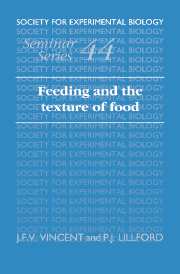Book contents
- Frontmatter
- Contents
- List of contributors
- Introduction
- Mechanical and fracture properties of cellular and fibrous materials
- Texture of plants and fruits
- Measuring meat texture and understanding its structural basis
- Food processing by mastication in cyprinid fish
- Quantitative aspects of the relationship between dentitions and diets
- The control of movements and forces during chewing
- The basic mechanics of mastication: man's adaptive success
- Integrating texture and physiology – techniques
- Brittle textures in processed foods
- The control and generation of texture in soft manufactured foods
- Texture and acceptability of human foods
- Index
The control and generation of texture in soft manufactured foods
Published online by Cambridge University Press: 14 January 2010
- Frontmatter
- Contents
- List of contributors
- Introduction
- Mechanical and fracture properties of cellular and fibrous materials
- Texture of plants and fruits
- Measuring meat texture and understanding its structural basis
- Food processing by mastication in cyprinid fish
- Quantitative aspects of the relationship between dentitions and diets
- The control of movements and forces during chewing
- The basic mechanics of mastication: man's adaptive success
- Integrating texture and physiology – techniques
- Brittle textures in processed foods
- The control and generation of texture in soft manufactured foods
- Texture and acceptability of human foods
- Index
Summary
To illustrate the origins of textures in a soft food, fish has been chosen as the example, since it is possible to show (1) how different process treatments applied to an unvarying raw material can produce different or similar textural properties, (2) how intrinsic and induced properties of the raw material can be responsible for different textures from a constant process, and (3) how novel products can be created based on the molecular properties of the raw material. As a result, this chapter is effectively divided into two main parts. The first describes three traditional fish product types which do not require an extreme alteration to the overall structural characteristics of the fish tissue; the second describes a product range where all native structure is broken down to gain access to the molecular properties of the materials comprising that structure.
Fish muscle structural organisation
Before dealing with those processes which affect texture but do not destroy the basic structural properties of fish muscle tissue, a description of that basic structure is necessary. The skeletal musculature of fish is segmented into a number of muscle blocks known as myotomes, which are separated from each other by encompassing sheaths of connective tissue called myocommata (Love, 1970). Each myo tome comprises a large number of muscle fibres (in general shorter than those in mammalian muscle), which run obliquely to the main axis of the muscle system. Figure 1 shows a typical fish muscle fibre, while Fig. 2 shows the arrangement of the myo tomes within a fillet (i.e. the musculature removed as a single cut from the side of a fish).
- Type
- Chapter
- Information
- Feeding and the Texture of Food , pp. 211 - 230Publisher: Cambridge University PressPrint publication year: 1991



